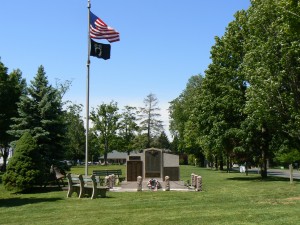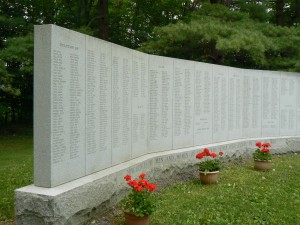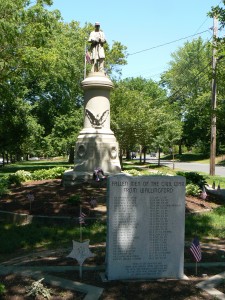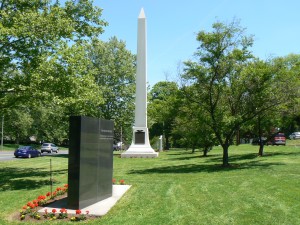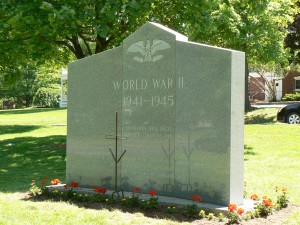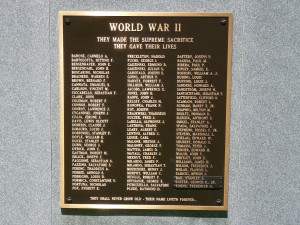 A large bronze and granite monument in Bridgeport’s Mountain Grove Cemetery honors local Civil War dead buried in distant battlefields.
A large bronze and granite monument in Bridgeport’s Mountain Grove Cemetery honors local Civil War dead buried in distant battlefields.
The Pro Patria (“For One’s Country” in Latin) monument was dedicated in 1906 by the local Grand Army of the Republic (GAR) post, with funding help from the state. The front (south) face of the monument features a large granite plaque that depicts an infantryman and a sailor standing with heads bowed.
The plaque, in five columns, lists the name, rank, regimental affiliation, and date and place of death of local residents killed in the war and not returned for burial. A dedication along the bottom reads “In loving memory of those who did not return.” A scrolling ribbon along the top of the plaque lists the battles of Fort Sumter (S.C.), Vicksburg, Mobile Bay, Antietam, Gettysburg and Appomattox.
 The monument was created by Bridgeport sculptor Paul Winters Morris, who also created the Abraham Lincoln bust on New Milford’s green.
The monument was created by Bridgeport sculptor Paul Winters Morris, who also created the Abraham Lincoln bust on New Milford’s green.
The monument, topped by a bronze sculpture of a soldier’s hat, coat and sword, stands at the front of a GAR plot containing 83 graves of Civil War veterans buried after the war. The corners of the GAR plot are marked by pyramids of cannonballs, which is uncommon in that most cannonballs that were incorporated into Civil War monuments were later removed during World War II metal drives.
Source:
Connecticut Historical Society: Civil War Monuments of Connecticut
Tags: Bridgeport
 Today, on the 146th anniversary of the conclusion of the Battle of Gettysburg, we look at a monument dedicated to Cornwall Hollow native Major General John Sedgwick, who fought at Gettysburg and was later killed at the Battle of Spotsylvania Court House (Va).
Today, on the 146th anniversary of the conclusion of the Battle of Gettysburg, we look at a monument dedicated to Cornwall Hollow native Major General John Sedgwick, who fought at Gettysburg and was later killed at the Battle of Spotsylvania Court House (Va).
Gen. Sedgwick, nicknamed “Uncle John” by his troops, is honored in his hometown with a monument at the intersection of Cornwall Hollow Road (Route 43) and Hautboy Hill Road.
The monument features a large granite slab that bears a bronze plaque depicting Sedgwick on the front (south) face. The dedication reads “This memorial, including ordnance used in the Mexican and Civil Wars and given by the government of the United States, in honour of Major General John Sedgwick, Commander of the Sixth Corps, Army of the Potomac, who gave his life for the preservation of the Union.”
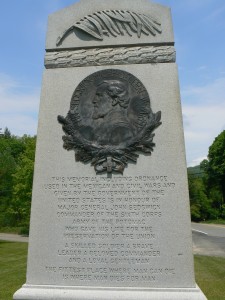
Beneath this dedication, the monument is inscribed with additional text: “A skilled soldier, a brave leader, a beloved commander and a loyal gentleman” and ‘The fittest place where man can die is where man dies for man.”
The north face lists some of Sedgwick’s battles in the Mexican-American War (Vera Cruz, Cerra Gordo, Puerla, Cherribusco, Molino Del Ray) and the Civil War (Fair Oaks, Antietam, Fredericksburg, The Wilderness and Spotsylvania)
An 1839 cannon stands on a granite base with a bronze eagle on its south face and wreaths on the east and west faces. The monument’s base has six pyramids of concrete cannonballs. The monument’s original cannonballs were removed in a World War II scrap drive (a common fate for cannonballs used in Civil War monuments).
The Sedgwick monument was originally dedicated in 1900. The monument was vandalized in 1976 and the 1980s, and most of the bronze ornamentation was stolen. Replicas were cast, based on the photos of the originals, and the monument was rededicated in 1994.
 Sedgwick, born in 1813, graduated from West Point in 1837 and served in the artillery during the Mexican-American War. During the Civil War, he served in the infantry and commanded the Sixth Corps of the Army of the Potomac.
Sedgwick, born in 1813, graduated from West Point in 1837 and served in the artillery during the Mexican-American War. During the Civil War, he served in the infantry and commanded the Sixth Corps of the Army of the Potomac.
Sedgwick was killed by a Confederate sniper on May 9, 1864, while directing artillery placement at Spotsylvania Court House. Sedgwick, attempting to rally his troops, said snipers (about 1,000 yards from Union troops) “couldn’t hit an elephant at this distance” just before being shot just below his left eye.
 Sedgwick is buried in the Cornwall Hollow Cemetery on the other side of the road. His grave, a tall obelisk, features the Sixth Corps emblem and the dates and location of his birth and death.
Sedgwick is buried in the Cornwall Hollow Cemetery on the other side of the road. His grave, a tall obelisk, features the Sixth Corps emblem and the dates and location of his birth and death.
A small marker in the ground immediately north of the Sedgwick monument indicates local schoolchildren planted a tree at the site in 1950. The tree has been removed, but portions of its stump are visible in the ground.
Sedgwick also honored with a statues at Gettysburg and West Point (often touched by students for luck with their exams) as well as a monument at the Spotsylvania battlefield.
Tags: Cornwall
 The more than 6,800 Americans killed in the World War II battle for the island of Iwo Jima are honored at the National Iwo Jima Memorial on the Newington/New Britain border.
The more than 6,800 Americans killed in the World War II battle for the island of Iwo Jima are honored at the National Iwo Jima Memorial on the Newington/New Britain border.
The monument, dedicated in 1995 by the Iwo Jima Survivors Association, is similar to the Marine Corps War Memorial in Arlington, Va. Both were based on an AP photograph depicting the raising of the American Flag over Mt. Suribachi on Iwo Jima by five Marines and a Navy hospital corpsman.
The Connecticut monument, which is almost 40 feet high, includes a bronze statue of the servicemen raising a 48-star flag. Rocks from Mt. Suribachi surround the figures’ feet, and sand from the invasion beach has been incorporated into the monument’s concrete.
 The front (west) face of the monument’s polished granite base lists Connecticut residents killed in the fight for Iwo Jima. The back of the base includes information about the battle, and lists the names of the servicemen depicted in the statue as well as those of the 27 men who received the Medal of Honor for their actions during the nearly month-long battle.
The front (west) face of the monument’s polished granite base lists Connecticut residents killed in the fight for Iwo Jima. The back of the base includes information about the battle, and lists the names of the servicemen depicted in the statue as well as those of the 27 men who received the Medal of Honor for their actions during the nearly month-long battle.
The north and south sides include engraved images from the battle, quotes about its significance and a map of the island.
The monument, visible from Connecticut’s Route 9, also has two granite monument honoring the service of the Medical Corps and military chaplains in the battle. An eternal flame burns from a black granite torch base north of the monument.
 Thanks to Dad for contributing the images for this post.
Thanks to Dad for contributing the images for this post.
Tags: New Britain, Newington
 A monument near the south end of Durham’s town green honors local residents who served in United States wars from the American Revolution to the present day.
A monument near the south end of Durham’s town green honors local residents who served in United States wars from the American Revolution to the present day.
The monument provides a comprehensive look at the nation’s wars by including conflicts, such as the War of 1812 and the 1846-48 War with Mexico, that are rarely highlighted on municipal greens.
The north face of the monument bears the dedication “Durham honors those who served their country. Plaques on the north face honor residents who served in World War I, World War II and Korea.
 The central plaque on the south face honors service in the American Revolution, the War of 1812 and the War with Mexico. Other plaques on the monument honor the Civil War, Vietnam, Desert Storm/Shield, and the current conflicts in Iraq and Afghanistan.
The central plaque on the south face honors service in the American Revolution, the War of 1812 and the War with Mexico. Other plaques on the monument honor the Civil War, Vietnam, Desert Storm/Shield, and the current conflicts in Iraq and Afghanistan.
The monument, surrounded by a chain-link fence and stone pillars, sits near the base of a flagpole.
Tags: Durham
 The 1885 Soldiers’ Monument at the northwest corner of Sharon’s town green is the only Civil War monument in Connecticut topped with a granite sculpture depicting a cannon.
The 1885 Soldiers’ Monument at the northwest corner of Sharon’s town green is the only Civil War monument in Connecticut topped with a granite sculpture depicting a cannon.
The distinctive monument was also among the first of the state’s monuments to feature a curved bench at its base (the 24th Regiment monument in Middletown has a similar bench).
The front (east) face of the monument bears the dedication “Erected by the town of Sharon in memory of the brave men who enlisted from this township in the war of the rebellion and fell in the struggle to maintain the Union.”
The north, west and south faces list a total of 28 residents lost in the conflict.
 According to a Sharon Historical Society newsletter, the cannon was damaged in the mid-20th century by local youths climbing on the monument. The granite cannon was replaced by a wooden replica, and was restored and returned to the monument in 1998. (The Connecticut Historical Society monument survey that helped inspire this blog describes the wooden cannon’s spongy condition in the early 1990s.)
According to a Sharon Historical Society newsletter, the cannon was damaged in the mid-20th century by local youths climbing on the monument. The granite cannon was replaced by a wooden replica, and was restored and returned to the monument in 1998. (The Connecticut Historical Society monument survey that helped inspire this blog describes the wooden cannon’s spongy condition in the early 1990s.)
At time of our Memorial Day weekend visit, a local bee had started constructing a nest in the depression marking the cannon’s muzzle.
The monument was designed by Emily O. Wheeler who, with her sisters, also designed the 1884 stone clock tower about four-tenths of a mile south, at the intersection of Main Street (Route 41) and Cornwall Hollow Road (Route 4).
An undated modern-era war memorial, across the street from the clock tower, has 13 granite panels listing local residents who served and died in wars ranging from the American Revolution to Desert Storm.
We’re not sure why, but there are differences between the listings found on the Soldiers’ Monument and the modern memorial. The newer memorial includes 35 names, compared with 28 names on the 1885 monument (which in turn lists three names not included on the newer memorial).
Sources:
Connecticut Historical Society, Civil War Monuments of Connecticut
Tags: Sharon
 A resting infantry soldier stands atop a circular-shafted monument dedicated in 1902 in Wallingford’s Dutton Park.
A resting infantry soldier stands atop a circular-shafted monument dedicated in 1902 in Wallingford’s Dutton Park.
The granite monument features a variety of shapes and ornamental details in its different sections. For instance, the monument’s square base is topped by an eight-sided band that in turn gives way to a cone-shaped cylinder. The infantry soldier stands atop a round base.
The monument’s front (south) face bears the dedication “Erected by Arthur H. Dutton Post No. 36 G.A.R. and the people of Wallingford to the memory of the brave men who died that their country might live,” as well as ornate carved wreathes inscribed with the Civil War years. (Similar wreaths on the monument honor the Army and the Navy.) The south shaft also bears a carved eagle.
 The east face lists the battles of Antietam (Md.), Gettysburg, Cedar Mountain (Va.) and Morris Island (S.C.).
The east face lists the battles of Antietam (Md.), Gettysburg, Cedar Mountain (Va.) and Morris Island (S.C.).
The north face lists the battles of Atlanta, New Orleans, Port Hudson (La.) and Appomattox (Va).
The west face lists the battles of New Berne (N.C.), Fort Fisher (N.C.), Chancellorsville (Va.) and Petersburg (Va.)
A granite memorial stone placed in front of the monument lists the names and regimental affiliations of 24 Wallingford residents killed in the Civil War. The memorial is not dated, but was clearly added after the larger monument was dedicated.
The cannon at the south end of the park was cast in 1830 at the West Point Foundry in Cold Spring, N.Y.
A triangular planting bed immediately north of the Soldiers’ Monument honors local residents who fought in the American Revolution. Plaques mounted in the base of the nearby flagpole honor local veterans’ organizations.
 A monument at the north end of the park honors residents who fought and died in the Vietnam War.
A monument at the north end of the park honors residents who fought and died in the Vietnam War.
Source:
Connecticut Historical Society: Civil War Monuments of Connecticut
Tags: Wallingford
 A collection of three monuments honoring service in the two World Wars and Korea stand in front of Wallingford’s town hall.
A collection of three monuments honoring service in the two World Wars and Korea stand in front of Wallingford’s town hall.
The World War I monument features two large bronze plaques, each with three columns listing local residents who fought in the conflict. The middle panel bears a dedication “in honor and in memory of those men and women of Wallingford who fought in the World War 1917-1918.”
The middle panel also bears a bronze bas relief plaque with marching soldiers and sailors, three of whom are carrying American flags. The monument is stopped with a large bronze eagle.
 The town’s World War II monument stands next to the World War I, and features seven plaques, each with three columns of names. The monument is undated, but appears to be of fairly recent vintage. A bronze eagle atop the monument was donated by local veterans’ organizations in 2001.
The town’s World War II monument stands next to the World War I, and features seven plaques, each with three columns of names. The monument is undated, but appears to be of fairly recent vintage. A bronze eagle atop the monument was donated by local veterans’ organizations in 2001.
A separate monument to the Korean War stands near the World War II monument. The Korean War monument has six bronze plaques, also with three columns listing local residents who served in the conflict. The monument also has five round plaques with the emblems of the country’s military service branches.
A separate plaque just below an eagle topping the monument lists the names of six residents killed in the Korean War.
 Wallingford’s construction of a separate Korean War monument is relatively uncommon, with many towns in the state including the Korean and Vietnam wars on a joint memorial.
Wallingford’s construction of a separate Korean War monument is relatively uncommon, with many towns in the state including the Korean and Vietnam wars on a joint memorial.
Tags: Wallingford
 U.S. Civil War Major General Joseph K. F. Mansfield and other local Civil War veterans are honored with monuments in Middletown’s Indian Hill Cemetery.
U.S. Civil War Major General Joseph K. F. Mansfield and other local Civil War veterans are honored with monuments in Middletown’s Indian Hill Cemetery.
Gen. Mansfield was born in New Haven in 1803, and was a career Army officer who served in the Corps of Engineers after graduating from West Point. During his military service, Mansfield lived in Middletown, and his Main Street home has been restored by the Middlesex County Historical Society.
Mansfield was mortally wounded on Sept. 17, 1862, during the Battle of Antietam, and returned to Middletown for burial.
 An ornate sandstone monument honoring Mansfield and his family is located in a central area of Indian Hill Cemetery, which rises above Middletown’s Washington Street (CT Route 66).
An ornate sandstone monument honoring Mansfield and his family is located in a central area of Indian Hill Cemetery, which rises above Middletown’s Washington Street (CT Route 66).
An inscription on the front (west) face of the Mansfield monument bears the general’s name, date and place of death, and his age. The inscription on the east face honors his wife, Louisa, who died in 1880. Inscriptions on the north and south faces list the couple’s two children.
There is an interesting contrast between the Mansfield name at the bottom of the east and west faces. On the west face, it stands out from the bottom of the monument, while on the east face, it is recessed.
The sarcophagus-shaped monument is topped by an elaborate carving of a U.S. flag, a sword and a hat.
 Not far from the Mansfield monument is an 1884 monument erected by the local Grand Army of the Republic (the veteran’s fraternal group formed after the Civil War) post that stands in a section of the cemetery reserved for local Civil War veterans.
Not far from the Mansfield monument is an 1884 monument erected by the local Grand Army of the Republic (the veteran’s fraternal group formed after the Civil War) post that stands in a section of the cemetery reserved for local Civil War veterans.
The granite monument depicts an infantry solider holding a rifle. A dedication on the front (east) face reads “To the memory of deceased soldiers & sailors by Mansfield Post No. 53, Department of Conn. G.A.R., A.D. 1884.”
The other three faces of the monument are generally plain, other than Army Corps emblems just beneath the base supporting the figure.
 The area around the monument has a number of graves of Civil War veterans.
The area around the monument has a number of graves of Civil War veterans.
In this post’s bottom image, Gen. Mansfield’s monument can be seen in the left third of the picture, across the road from the GAR monument (in the gap between the large trees).
Sources:
Connecticut Historical Society: Civil War Monuments of Connecticut: Mansfield, GAR
Wikipedia: Joseph K. Mansfield
Tags: Middletown
 A collection of monuments on Veterans’ Memorial Green along Washington Street in Middletown honors those who served in the Civil War, the two World Wars, Korea and Vietnam.
A collection of monuments on Veterans’ Memorial Green along Washington Street in Middletown honors those who served in the Civil War, the two World Wars, Korea and Vietnam.
A 1904 monument near the western end of the green honors the 24th Regiment Connecticut Volunteers, a Civil War unit that fought primarily in Louisiana. The monument features a short column flanked by two curved benches and a sphere topped by a bronze eagle. The front (north) face of the monument bears the numeral 24 in a wreath, and lists the battle of Port Hudson. A bronze plaque is inscribed with a dedication “Erected by members of the 24th C.V., citizens of Middletown and [the] state of Connecticut 1904.”
 The west face of the monument lists the battle of Irish Bend. The south face lists the battle of Donaldsonville, and bears a plaque honoring about 75 members of the regiment who were killed in action, had died from wounds, or had died after the war’s conclusion. The east face lists the battle of Baton Rouge.
The west face of the monument lists the battle of Irish Bend. The south face lists the battle of Donaldsonville, and bears a plaque honoring about 75 members of the regiment who were killed in action, had died from wounds, or had died after the war’s conclusion. The east face lists the battle of Baton Rouge.
Further east on the green, a polished black granite monument honors the veterans of the Korean and Vietnam wars. Four large panels bears service emblems and the years of the two conflicts, as well as a dedication “Beyond the far Pacific to the rim of Asia they went – twice in a generation – to risk all for honor and freedom.”
The monument’s rear lists two residents who were killed in Vietnam.
Further east, a tall white obelisk honors 37 soldiers and sailors who died in World War I. A plaque on the south side lists the names of the war heroes, while a plaque on the west side lists the names of seven battles.
 Nearby, three polished granite panels honor the service of World War II veterans. The front bears the dedications “Their devotion and sacrifices contributed to final victory” and “Dedicated to the men and women of Middletown who served in the armed forces of their country in time of war.”
Nearby, three polished granite panels honor the service of World War II veterans. The front bears the dedications “Their devotion and sacrifices contributed to final victory” and “Dedicated to the men and women of Middletown who served in the armed forces of their country in time of war.”
The rear bears a bronze plaque with three columns listing residents who were lost in the war.
Source:
Connecticut Historical Society: Civil War Monuments of Connecticut
Tags: Middletown
 We start this week’s look at the impressive war monuments in Middletown at the city’s South Green, where local residents lost in the Civil War are honored with the 1874 Soldiers’ Monument.
We start this week’s look at the impressive war monuments in Middletown at the city’s South Green, where local residents lost in the Civil War are honored with the 1874 Soldiers’ Monument.
The monument features a bronze infantry figure atop a granite base. A dedication on the front (northeast) face of the monument reads “erected by the town of Middletown to the memory of her fallen sons 1874.” The front also has a bronze plaque depicting a farming family and a scrolling ribbon bearing an additional dedication “their heroic valor ensured our lasting peace.”
A small round plaque set just below the soldier’s feet bears the additional inscription “Honor to the brave” inside an ornamental wreath.
 The northwest, southwest and southeast sides of the monument bear large plaques listing the name, regimental affiliation, and date and place of death of local residents who were killed in action, died of wounds, in prison or after the war.
The northwest, southwest and southeast sides of the monument bear large plaques listing the name, regimental affiliation, and date and place of death of local residents who were killed in action, died of wounds, in prison or after the war.
The rear (southwest) side also features a bronze inset with a wreath and the inscription “we cherish their memory.” The southeast face features a small bust of Abraham Lincoln, and the northwest face has a bronze inset depicting George Washington.”
The first name listed on the southeast face is Maj. Gen. Joseph Mansfield, a Middletown native who was killed in the battle of Antietam. His grave, and a GAR monument near it, will be featured in Friday’s post.
 The infantry statue atop the monument was cast in Chicopee, Mass., and bears the name of sculptor M.H. Mossman on the northwest base of the statue.
The infantry statue atop the monument was cast in Chicopee, Mass., and bears the name of sculptor M.H. Mossman on the northwest base of the statue.
The base of the Soldier’s Monument is surrounded by four Confederate cannons.
Across Main Street, two large plaques honor Middletown residents who served in World War I. The plaques were attached to the outside walls of an armory building that was later converted into an inn.
Tags: Middletown











